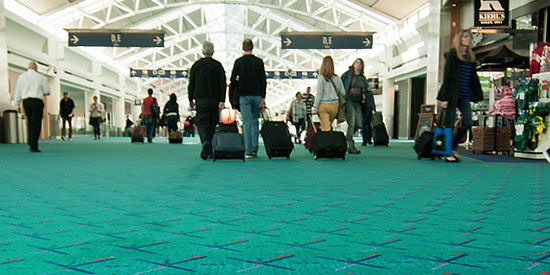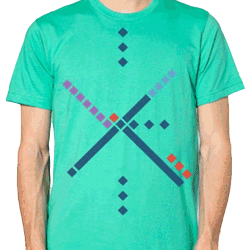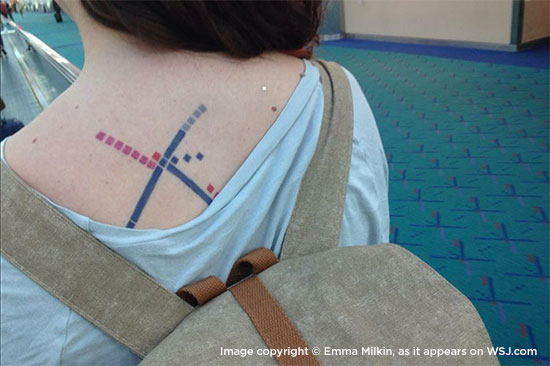 If you have read any of my previous posts, you will agree with me that people are sentimental about brands. That’s because in order for a company, product or service to be effective and relevant, it must connect emotionally with its audience. Brands build trust, they build goodwill and loyalty, and they build memories.
If you have read any of my previous posts, you will agree with me that people are sentimental about brands. That’s because in order for a company, product or service to be effective and relevant, it must connect emotionally with its audience. Brands build trust, they build goodwill and loyalty, and they build memories.
 One brand that is breaking the hearts of many is Portland International Airport, or PDX as Oregonians refer to it. Why? Because their beloved teal carpet, that is a symbol of the airport and their home, is being torn out and replaced after 20 years of wear and tear. Admittedly, I have visited Portland’s airport a couple of times, and I really didn’t give much thought about the carpet I was treading on.
One brand that is breaking the hearts of many is Portland International Airport, or PDX as Oregonians refer to it. Why? Because their beloved teal carpet, that is a symbol of the airport and their home, is being torn out and replaced after 20 years of wear and tear. Admittedly, I have visited Portland’s airport a couple of times, and I really didn’t give much thought about the carpet I was treading on.  The PDX carpet, however, is different. Primarily teal (hello, 1993!), it consists of a pattern of dark blue, purple, and red crisscrossed lines that represent the view air traffic controllers would have of the airport’s runways. To Portlanders, this pattern has obtained a cult-like following. According to a recent article in the Wall Street Journal, on Twitter there are over 1,500 followers (of the carpet!), thousands of pins are posted on Pinterest, and 31,000 photos on Instragram of feet on the carpet. Visit madeinoregon.com and there are dozens of products that pay homage to the iconic carpet, including apparel, home goods, and even beer brands. Some residents of the city have gone so far as to permanently ink the pattern on their body.
The PDX carpet, however, is different. Primarily teal (hello, 1993!), it consists of a pattern of dark blue, purple, and red crisscrossed lines that represent the view air traffic controllers would have of the airport’s runways. To Portlanders, this pattern has obtained a cult-like following. According to a recent article in the Wall Street Journal, on Twitter there are over 1,500 followers (of the carpet!), thousands of pins are posted on Pinterest, and 31,000 photos on Instragram of feet on the carpet. Visit madeinoregon.com and there are dozens of products that pay homage to the iconic carpet, including apparel, home goods, and even beer brands. Some residents of the city have gone so far as to permanently ink the pattern on their body.
 Most people might not think or care much about the carpet they walk on, and this is true of most products or services that we use—generally we take them for granted. The key to creating a memorable brand is to connect emotionally with your audience. Use messaging, graphics and images that tell them a story: one that is relatable, believable, and familiar.
A Relatable brand is one that is personable. The target audience understands the brand at a visceral level, including what the product or service is, what it does, and why it matters to them. People should just "get it." Apple incorporates such an intuitive user experience with every one of its products that it has developed a loyal following of brand advocates.
Believable brands are authentic: they don't try to pretend to be something they're not. Any claims that your brand makes about solving a need or problem must be backed up by evidence. Using customer testimonials, anecdotes, analogies, or qualitative information ("just the facts, ma'am") helps make your case. Google and FedEx have been so ingrained in culture that they are now used as verbs: we "google" information on the web and we "FedEx" overnight packages.
Familiar brands are those that make us feel comfortable. These brands are loyal to their customers and never let them down. They are nostalgic, throw-backs, or "retro," in that they reference the past, and often simpler times. They are dependable, and hardly ever change. Whether you are in the Middle East, China, or Europe, Coca-Cola and McDonald's look and feel the same.
The PDX carpet is an example of a familiar brand. It reminds Portlanders of their home, so much so that it has created a loyal following. So how are you exciting people about your brand, so they will be just as sentimental, and even downright fanatical, about it?
By: Ryan Hembree, Principal | Brand & Creative Strategy
Most people might not think or care much about the carpet they walk on, and this is true of most products or services that we use—generally we take them for granted. The key to creating a memorable brand is to connect emotionally with your audience. Use messaging, graphics and images that tell them a story: one that is relatable, believable, and familiar.
A Relatable brand is one that is personable. The target audience understands the brand at a visceral level, including what the product or service is, what it does, and why it matters to them. People should just "get it." Apple incorporates such an intuitive user experience with every one of its products that it has developed a loyal following of brand advocates.
Believable brands are authentic: they don't try to pretend to be something they're not. Any claims that your brand makes about solving a need or problem must be backed up by evidence. Using customer testimonials, anecdotes, analogies, or qualitative information ("just the facts, ma'am") helps make your case. Google and FedEx have been so ingrained in culture that they are now used as verbs: we "google" information on the web and we "FedEx" overnight packages.
Familiar brands are those that make us feel comfortable. These brands are loyal to their customers and never let them down. They are nostalgic, throw-backs, or "retro," in that they reference the past, and often simpler times. They are dependable, and hardly ever change. Whether you are in the Middle East, China, or Europe, Coca-Cola and McDonald's look and feel the same.
The PDX carpet is an example of a familiar brand. It reminds Portlanders of their home, so much so that it has created a loyal following. So how are you exciting people about your brand, so they will be just as sentimental, and even downright fanatical, about it?
By: Ryan Hembree, Principal | Brand & Creative Strategy